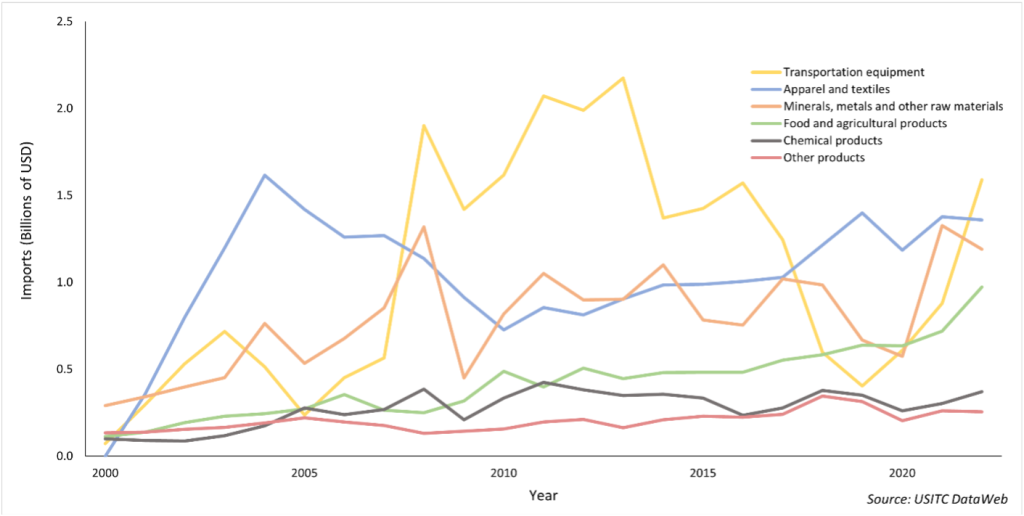In brief: The future of US-Africa trade and investment
Top lines
- AGOA gives duty-free access to the US market for eligible countries in sub-Saharan Africa, aiming to promote African economic development alongside market liberalization and democratic governance.
- With AGOA due to expire in 2025, policymakers in the US and Africa must decide the basis for stronger US-Africa trade going forward.
- The future of AGOA is not guaranteed. AGOA should be renewed by the US Congress for at least a ten-year period as soon as possible. Doing so could allow African economies to capitalize on efforts to diversify supply chains away from China, supporting US strategic interests and a more resilient global economy.
WORTH A THOUSAND WORDS
In 2022, US imports of goods utilizing AGOA (or GSP) benefits was valued at $10.2 billion. Like overall US imports from Africa, imports from AGOA beneficiaries have changed over time, driven mostly by the value of oil imports from countries like Nigeria and Angola.

THE DIAGNOSIS
Since 2000, the cornerstone of US trade policy for Africa has been the African Growth and Opportunity Act also known as AGOA.
Past work by the Atlantic Council suggests that Africa sits at the nexus of current development, climate, and security challenges. With global competition over resources, technology and influence growing, the strategic importance of establishing a new kind of relationship with Africa has become clear to the United States. With an African market of over 1.3 billion people and a combined Gross Domestic Product (GDP) of over $3.4 trillion, expanding US-Africa trade and investment is now a clear strategic priority for both the United States and African countries.
The Atlantic Council’s Africa Center is examining trade between the US and Africa to date and the impact of AGOA, and analyzing the future of AGOA after its potential expiration in 2025. Our work draws on a survey and interviews conducted with leaders in government, business, international organizations, and civil society. The report identifies key constraints limiting trade expansion and examines emerging challenges and opportunities that will shape its future. Drawing on this analysis, the report provides actionable recommendations for policymakers and other key stakeholders on the future of AGOA.
AGOA has come to define much of United States’ commercial relationship with Africa. With AGOA set to expire in 2025 and the shifting world economy providing new challenges and opportunities, now is the time to decide the future of US-Africa trade. The analysis in this report, as well as the findings from survey responses and interviews, suggest recommendations covering three areas:
- AGOA itself
- the future of US-Africa trade more broadly, and
- the even broader future of US-Africa relations.
THE PRESCRIPTION
How to seize the moment
AGOA has symbolized the shift in US perceptions of Africa, augmenting aid with trade and commercial opportunity. Recognizing that the next ten years will shape economic trajectories for decades to come, the US must build on its narrative investment by embedding greater certainty for US and African investors.
- AGOA should be renewed by the US Congress for at least a ten-year period as soon as possible. Doing so could allow African economies to capitalize on efforts to diversify supply chains away from China, supporting US strategic interests and a more resilient global economy.
- AGOA’s extension should be combined with greater certainty about AGOA eligibility, with fewer short-term eligibility decisions wherever possible. Eligibility is necessary for a country to access AGOA benefits. Doing so will boost investor confidence and support long-term economic development, which is the best way for the US to achieve its broader commercial and political goals. Greater stability in AGOA eligibility will also enhance the United States’ support for African economic integration through the AfCFTA.
- Existing US efforts, through USAID, USTR and other agencies, should continue and ensure that support through continental level initiatives is sufficiently attuned to local contexts and barriers. Support to countries and firms in Africa is needed to ensure that the benefits of AGOA in fueling long-term development are achieved. There is a need for stronger capacity building to translate AGOA eligibility into utilization and real export capacity. Investing in re-establishing regional trade hubs could do this, while also supporting regional trade integration and direct links between AGOA and Africa’s Regional Economic Communities. USAID should ensure all regions, including Francophone Central Africa, are supported in this work.
- To realize the benefits of AGOA for long-term development, African governments should rapidly develop and regularly update realistic national AGOA strategies and embed them in their economic planning and public investment.The US Congress should ensure sufficient funding for US agencies to support this process, including dedicated staff to work with African governments to draft the plans, if necessary. Support for these strategies could help set the United States’ interaction with Africa apart from other countries like China and India.Selecting a few countries to support early could make a big difference. This could include eligible countries that are finding it difficult to meet the criteria such as the Central African Republic, Liberia, or the Democratic Republic of Congo.
- To support greater investment in export-oriented sectors within African countries, the US DFC, Millennium Challenge Corporation, and the Prosper Africa initiative should align their financing and commercial facilitation with these AGOA strategies too. The future of US-Africa trade should be situated within a broader reorientation of the US-Africa relationship that builds true partnerships that not only yield economic opportunities and expanded trade but also serve longer-term social and political goals. New forms and arenas for collaboration between US and African actors could drive unique solutions in a multipolar world. Such strategies could also include countries that are important to US-Africa trade but face eligibility constraints such as Cameroon, Ethiopia, and Somalia.
BOTTOM LINES
With so much written about the future of AGOA itself, the future of US-Africa trade more broadly, and the even broader future of US-Africa relations, a thorough examination of AGOA eligibility in 2023 is an opportunity to begin a longer conversation about the future of AGOA and US-Africa trade and investment.
As the United States reorients its international economic policy and African countries build new approaches to economic integration and collaboration, the future of US-Africa trade is ready to be defined. While setting the course for a renewed AGOA is important for maintaining business confidence, many of the challenges that African countries, firms, and individuals face will require deeper structural responses. In the push to achieve inclusive growth across the continent, capacity and investment constraints are particularly clear.
There are also immense opportunities. The rise of digital, financial, and creative products and services will shape African economies going forward. The expansion of economic and political links across the continent will provide more unified markets and supply chains, with greater economies of scale. The resources, ideas, and human capital needed to deliver global public goods and the green energy transition are already making Africa central to the future economy. Taking steps to broaden and deepen US-Africa trade and collaboration in these directions will provide the basis for more inclusive, sustainable growth and serve strategic economic and political goals for both sides.
Like what you read? Check back for our full report, coming soon.

The Africa Center works to promote dynamic geopolitical partnerships with African states and to redirect US and European policy priorities toward strengthening security and bolstering economic growth and prosperity on the continent.
Image: Kenyan workers prepare men's underwear at the Hela intimates export processing zone (EPZ) limited factory in Athi River, near Nairobi, Kenya, July 27, 2017. Picture taken July 27, 2017. REUTERS/Thomas Mukoya
